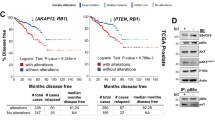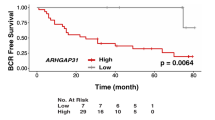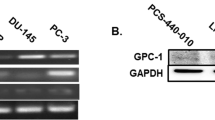Abstract
An abnormal stimulation of cAMP signaling cascade has been implicated in various human carcinomas. Since the agents activating GSα-mediated signaling pathways have been shown to increase in vitro proliferation of prostate cancer cells, present studies examined the GSα-mediated signaling in tumorigenicity and invasiveness of PC-3M prostate cancer cells. PC-3M cells were stably transfected with plasmids containing either wild type (GSα-WT) or constitutively active (gsp mutant of GSα or GSα-QL) cDNAs. The stable transfectants were then tested for: (1) colony formation in soft agar; (2) cell migration and penetration of basement matrix in an in vitro invasion assay; and (3) the ability to form tumors and metastases in nude mice. PC-3M cells expressing GSα-QL protein displayed 15-fold increase in their ability to migrate and penetrate the basement membrane as compared to parental PC-3M cells or those expressing GSα-WT. GSα-QL transfectants also displayed a dramatically greater rate of growth in soft agar, and greater tumorigenicity and metastasis forming ability when orthotopically implanted in nude mice. All mice receiving PC-3M cells produced primary tumors within 5 weeks after implantation. However, the cells expressing GSα-QL displayed a significantly faster tumor growth as assessed by prostate weight (greater than 20-fold as compared to PC-3M cells), and produced metastases in kidneys, lymph nodes, blood vessels, bowel mesentery and intestine. Interestingly, expression of GSα-WT reduced the ability of PC-3M cells to form tumors in nude mice. These results suggest that persistent activation of GSα-mediated signaling cascade can dramatically accelerate tumorigenesis and metastasizing ability of prostate cancer cells.
This is a preview of subscription content, access via your institution
Access options
Subscribe to this journal
Receive 50 print issues and online access
$259.00 per year
only $5.18 per issue
Buy this article
- Purchase on Springer Link
- Instant access to full article PDF
Prices may be subject to local taxes which are calculated during checkout




Similar content being viewed by others
References
Abdul M, Anezinis PE, Logothetis CJ and Hoosein NM. . 1994 Anticancer Res. 14: 1215–1220.
Aprikian AG, Cordon Cardo C, Fair WR, Zhang ZF, Bazinet M, Hamdy SM and Reuter VE. . 1994 J. Urol. 151: 914–919.
Aprikian AG, Han K, Chevalier S, Bazinet M and Viallet J. . 1996 J. Mol. Endocrin. 16: 297–306.
Banerjee A, Xu HJ, Hu SX, Araujo D, Takahashi R, Stanbridge EJ and Benedict WR. . 1992 Cancer Res. 52: 6297–6304.
Carmena MJ, Garcia-Paramio P, Solano RM and Prieto JC. . 1995 Prostate 27: 204–211.
Chen C, Poulin R and Labrie F. . 1996 J. Steroid Biochem. Mol. Biol. 58: 489–494.
Clapham DE. . 1993 Cell 75: 1237–1239.
Cohen MK, Arber DA, Coffield KS, Keegan GT, McClintock J and Speights VOJ. . 1994 Cancer 74: 1899–1903.
di Sant'Agnese PA. . 1992 Cancer 70: 254–268.
Drews RT, Gravel RA and Collu R. . 1992 Mol. Cell Endocrinol. 87: 125–129.
Faure M and Bourne HR. . 1995 Mol. Biol. Cell. 6: 1025–1035.
Gaiddon C, Boutillier AL, Monnier D, Mercken L and Loeffler JP. . 1994 J. Biol. Chem. 269: 22663–22671.
Gup DI, Shapiro E, Baumann M and Lepor H. . 1990 J. Urol. 143: 179–185.
Hoosein NM, Logothetis CJ and Chung LW. . 1993 J. Urol. 149: 1209–1213.
Huang ZY, Meng FQ and Chen H. . 1994 Chung, Hua, I, Hsueh, Tsa, Chih. 74: 23–25.
Juarranz MG, Guijarro LG, Bajo AM, Carmena MJ and Prieto JC. . 1994 Gen. Pharmacol. 25: 509–514.
Kadmon D, Thompson TC, Lynch GR and Scardino PT. . 1991 J. Urol. 146: 358–361.
Killam AL, Watts SW and Cohen ML. . 1995 Eur. J. Pharmacol. 273: 7–14.
Langer DJ, Kuo A, Kariko K, Ahuja M, Klugherz BD, Ivanics KM, Hoxie JA, Williams WV, Liang BT and Cines DB. . 1993 Circ. Res. 72: 330–340.
Lefkowitz RJ. . 1993 Nature 365: 603–604.
Lepor H and Kuhar MJ. . 1984 J. Urol. 132: 397–402.
Logothetis C and Hoosein N. . 1992 J. Cell. Biochem. 16 (Suppl.): H128–H134.
Logothetis CJ, Hoosein NM and Hsieh JT. . 1994 Semin. Oncol. 21: 620–629.
Lopez-Ilasaca M, Li W, Uren A, Yu JC, Kazlauskas A, Gutkind JS and Heidaran MA. . 1997 Biochem. Biophys. Res. Commun. 232: 273–277.
Mira-y-Lopez R, Jaramillo S and Waxman S. . 1992 J. Biol. Chem. 267: 23063–23068.
Muca C and Vallar L. . 1994 Oncogene 9: 3647–3653.
Murga C, Laguinge L, Wetzker R, Cuadrado A and Gutkind JS. . 1998 J. Biol. Chem. 273: 19080–19085.
Newling DW. . 1992 Prostate 4: (Suppl.) 139–143.
Newling DW. . 1996 Eur. Urol. 29: (Suppl. 2)69–74.
Rayford W, Noble MJ, Austenfeld MA, Weigel J, Mebust WK and Shah GV. . 1997 Prostate 30: 160–166.
Reubi JC. . 1995 J. Nucl. Med. 36: 1846–1853.
Segal NH, Cohen RJ, Haffejee Z and Savage N. . 1994 Arch. Pathol. Lab. Med. 118: 616–618.
Shah GV, Rayford W, Nobel MJ, Austenfeld M, Weigel J, Vamos S and Mebust WK. . 1994 Endocrinology 134: 596–602.
Shintani Y, Yoshimoto K, Horie H, Sano T, Kanesaki Y, Hosoi E, Yokogoshi Y, Bando H, Iwahana H and Kannuki S. . 1995 Endocrin. J. 42: 331–340.
Solano RM, Carmena MJ, Guijarro LG and Prieto JC. . 1994 Neuropeptides 27: 31–37.
Solano RM, Carmena MJ, Carrero I, Cavallaro S, Roman F, Hueso C, Travali S, Lopez-Fraile N, Guijarro LG and Prieto JC. . 1996 Endocrinology 137: 2815–2822.
Stephenson RA, Dinney CPN, Gohji K, Ordonez NG, Killion JJ and Fidler IJ. . 1992 J. NCI 84: 951–957.
Tanaka K, Iwamoto Y, Ito Y, Ishibashi T, Nakabeppu Y, Sekiguchi M and Sugioka Y. . 1995 Cancer Res. 55: 2927–2935.
van Weerden WM, Moerings EP, van Kreuningen A, de Jong FH, van Steenbrugge GJ and Schroder FH. . 1993 Cell Prolif. 26: 67–75.
Wu G, Burzon DT, di Sant'Agnese PA, Schoen S, Deftos LJ, Gershagen S and Cockett AT. . 1996 Urology 47: 376–381.
Young MR, Montpetit M, Lozano Y, Djordjevic A, Devata S, Matthews JP, Yedavalli S and Chejfec G. . 1995 Int. J. Cancer 61: 104–109.
Zeiger MA and Norton JA. . 1993 Surgery 114: 458–462.
Acknowledgements
This work was supported by grant DK-45044 (to GV Shah) from the National Institutes of Health. Authors thank Dr R Iyengar for providing plasmids GSα-WT and GSα-QL.
Author information
Authors and Affiliations
Rights and permissions
About this article
Cite this article
Chien, J., Wong, E., Nikes, E. et al. Constitutive activation of stimulatory guanine nucleotide binding protein (GSαQL)-mediated signaling increases invasiveness and tumorigenicity of PC-3M prostate cancer cells. Oncogene 18, 3376–3382 (1999). https://doi.org/10.1038/sj.onc.1202690
Received:
Revised:
Accepted:
Published:
Issue Date:
DOI: https://doi.org/10.1038/sj.onc.1202690
Keywords
This article is cited by
-
MAP kinase pathways and calcitonin influence CD44 alternate isoform expression in prostate cancer cells
BMC Cancer (2008)
-
A role for candidate tumor-suppressor gene TCEAL7 in the regulation of c-Myc activity, cyclin D1 levels and cellular transformation
Oncogene (2008)
-
Comparative proteome analysis of human lung squamous carcinoma tissue
The Chinese-German Journal of Clinical Oncology (2006)
-
Prostate cancer invasion is influenced more by expression of a CD44 isoform including variant 9 than by Muc18
Laboratory Investigation (2004)
-
G-protein αolf subunit promotes cellular invasion, survival, and neuroendocrine differentiation in digestive and urogenital epithelial cells
Oncogene (2002)



